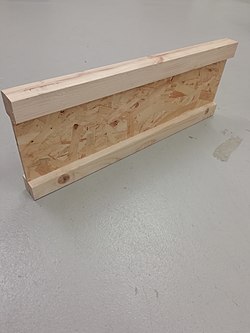

An engineered wood joist, more commonly known as an I-joist, is a product designed to eliminate problems that occur with conventional wood joists. Invented in 1969, the I-joist is an engineered wood product that has great strength in relation to its size and weight. The biggest notable difference from dimensional lumber is that the I-joist carries heavy loads with less lumber than a dimensional solid wood joist.[1] As of 2005, approximately 50% of all wood light framed floors used I-joists.[2][clarification needed] I-joists were designed to help eliminate typical problems that come with using solid lumber as joists.
The advantage of I-joists is they are less likely to bow, crown, twist, cup, check, or split as would a piece of dimensional lumber. I-joists' dimensional soundness and little or no shrinkage help eliminate squeaky floors.
The disadvantage of I-joists is very rapid structural failure when directly exposed to fire (much like trusses), reducing the time available for residents to escape and increasing the danger to firefighters.
